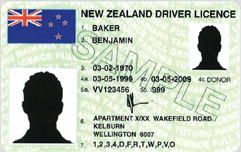Categories: New Zealand has beautiful weather, especially in the summer. Long sunny days spent on the beach, tramping (hiking) in the mountains and exploring your new country is very exciting. The sun in New Zealand however is a double edged sword as the levels of UV radiation is a lot higher than in South Africa. The... Read more |
The post The sun in New Zealand appeared first on South Africans Going To New Zealand.
]]>
Chillin’ in the hammock on a hot summer day. Photograph by Sherelee Clarke.
New Zealand has beautiful weather, especially in the summer. Long sunny days spent on the beach, tramping (hiking) in the mountains and exploring your new country is very exciting. The sun in New Zealand however is a double edged sword as the levels of UV radiation is a lot higher than in South Africa. The reason for this is that the hole in the ozone layer over the arctic is positioned in such a way that it lets in harmful UV rays which are able to reach New Zealand.
For this reason New Zealand currently has one of the highest Melanoma rates in the world. In the past decade Melanoma rates have jumped 14 percent in New Zealand with almost one Melanoma related death per day.
Although 70 percent of Melanoma cases occur in those 50 years or older, it is commonly believed that the causes of Melanoma can be traced back as far as your childhood. In other words overexposure to the harmful UV rays in your youth can cause Melanoma later in life.
This means that we need to protect ourselves, and especially our children now.
The way we do this is to slip, slop, slap, wrap and slide. HAHA, let me explain:
Slip : Slip on a shirt. This protects your upper body. Even when swimming, you are still being burnt by the sun.
Slop : Slop on 30+ protection factor sunscreen. The higher factor the better. Remember that you do still tan with the sunscreen on, it just blocks the harmful UV rays. Always re-apply after you come out of the water, and don’t forget to apply to your hands, feet and ears too.
Slap : Slap a hat on your head to protect your face. A broad rim hats does the best job.
Wrap : Wrap your eyes with some sunglasses.
Slide : Slide into the shade during the hottest time of the day (11am to 3pm)
Don’t underestimate the sun in New Zealand. The sun is harsh and strong in South Africa, but most of us could still lie in the sun most of the day without any sunblock and not give it a second thought. It’s not like that here. Just 30 minutes in the sun without sunscreen on and you know all about it.
You have moved to New Zealand to give your family a better, safer life. Now keeps them safe from the sun too.
The post The sun in New Zealand appeared first on South Africans Going To New Zealand.
]]>Categories: New Zealand actually has two national anthems, God Defend New Zealand and God Save the Queen. The New Zealand national anthem is very popular. God Defend New Zealand is however the New Zealand national anthem sung in schools, at official events and International sporting events. Below is a video of the full New Zealand national anthem with... Read more |
The post New Zealand National Anthem appeared first on South Africans Going To New Zealand.
]]>
New Zealand actually has two national anthems, God Defend New Zealand and God Save the Queen. The New Zealand national anthem is very popular.
God Defend New Zealand is however the New Zealand national anthem sung in schools, at official events and International sporting events.
Below is a video of the full New Zealand national anthem with subtitles added so you can learn it:
You will however find that the full anthem is very seldom sung as it is so long. Only the first two verses are usually sung here they are :
E Ihowā Atua
O ngā iwi mātou rā
Āta whakarangona
Me aroha noa
Kia hua ko te pai
Kia tau tō atawhai
Manaakitia mai
Aotearoa
God of Nations at Thy feet,
In the bonds of love we meet,
Hear our voices, we entreat,
God defend our free land.
Guard Pacific’s triple star
From the shafts of strife and war,
Make her praises heard afar,
God defend New Zealand.
For interest sake, this is what the Maori verse translates to:
O Lord, God,
of all people
Listen to us,
Cherish us
May good flourish,
May your blessings flow.
Defend
Aotearoa
The Kiwis are a very proud nation and being able to stand up alongside them and sing the New Zealand national anthem as a fellow Kiwi is an awesome feeling, especially when we are playing the Ozzies ![]()
The post New Zealand National Anthem appeared first on South Africans Going To New Zealand.
]]>Categories: Luckily for us, driving in New Zealand is not much different to driving in South Africa. In this article we will take a look at how to convert your South African driver’s licenses to their Kiwi equivalents and what the differences are between driving in the two countries. How to convert your SA drivers license... Read more |
The post Driving in New Zealand appeared first on South Africans Going To New Zealand.
]]>
Luckily for us, driving in New Zealand is not much different to driving in South Africa. In this article we will take a look at how to convert your South African driver’s licenses to their Kiwi equivalents and what the differences are between driving in the two countries.
How to convert your SA drivers license into a Kiwi drivers license.
It couldn’t be any easier to be honest. When you arrive you are allowed to drive on your South African license for up to 12 months.
Driving Tip
We recommend that you do this for a while before converting your license. That way if you do get a fine while getting used to the difference in the speed limit, you will not get any demerit points on your New Zealand license.
When you are ready to convert your license, simply walk into any branch of the AA or VINZ (Vehicle Inspection New Zealand). You will need to take with you:
1) Your passport
2) Proof of Address like a utility bill
3) Your South African driver’s license
Make copies of each of these to take with as well.
You will then fill in an application form. They will then take a photo of you for your license as well as do a quick eye test. You will then pay around $50 to process the application.
You will then be issued a slip which confirms that you have applied for your New Zealand drivers license. If you are asked for your drivers license while you are waiting for the proper one to arrive, you will then need to produce this temporary license, so keep it with you at all times.
Your actual New Zealand drivers license will then arrive in the post a week or so later and will look like this:
Always carry your licence with you
You will always carry your drivers license on you as it is not only used to prove you have a valid drivers license, but it is also used to prove your identity when required, eg., at the bank or when opening an account at a store.
The difference between driving in New Zealand and South Africa
There are surprisingly few differences between driving in the two countries, so you will feel pretty much at home on the roads. There are however a few signs and road markings that are new which you will need to learn.
Left Turn Rule
Please note that the bizarre left turn right of way rule that used to be law in New Zealand does not apply anymore. You will use all the same turning rules that you used to use in South Africa. In other words if you are turning left, then the car on the opposite side of the road will need to wait for you as you have right of way.
The first and most significant difference is the speed limit. In built up areas it will generally be 50km/h and on the motorway it is 100km/h. The speed limit is calculated according to a formula, so pay careful attention to the signs as it can vary in built up areas between 50km/h and 70km/h.
On rural roads the limit will also vary, usually between 80km/h and 100km/h. Here you need to learn your first new sign – the De-restriction sign :

This sign tells you that you can now drive 100km/h again.
Also on rural roads you will often notice this sign :

It tells you that there is a single lane bridge ahead. The two arrows tell you which traffic has the right of way. The larger thicker arrow has the right of way. In the example above the oncoming traffic has right of way, so if there are oncoming traffic, you will need to stop behind the line in front of the bridge until that traffic has passed.
In built up areas you will often see this sign :

You will usually find the sign at traffic lights. It is pretty self explanatory, but I am pointing it out because sometimes the sign only says “Peds” instead of “Pedestrians”. So now you know what a Ped is.
When entering a busy motorway, you will often see a traffic light near the end of the on ramp. There will also be a sign like this below the traffic light :
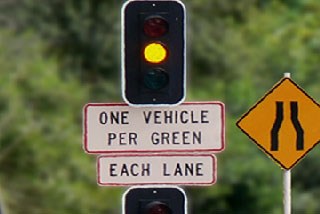
This traffic light will cycle quickly between green, red and yellow. The idea with these traffic lights is to reduce the amount of congestion on the motorway during peak traffic. You treat it as though it is a regular traffic light and will notice that it will generally let one car pass through at a time before changing.
Certain lanes are bus lanes only. These are often marked using a difference colour tar (usually red) as well as this sign overhead :
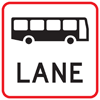
There are however times when these lanes can be used by regular traffic as well. If this is the case, then you will see a time sign along with the bus lane sign :
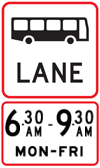
In certain areas you are not allowed to stop. These areas are marked like this :
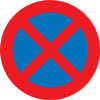
There may also be times when you can stop in these areas. The times when you may not stop there will be marked on the sign :

Around schools, the speed limit is 40km/h. The start of the school zone is marked as follows :

the end of the 40km/h zone is marked like this :

Pedestrian crossings are very clearly marked with sign posts that look like this :
![]()
as well as having the standard zebra markings on the road.
If there are pedestrians approaching or standing at the crossing you MUST stop.
WARNING
You cannot just ride and they will wait for you like in South Africa. Folks here are so used to the cars stopping for them that they sometimes just walk without even looking if there are cars coming. This is especially true of school children, so please be very careful around pedestrian crossings when you first arrive.
The post Driving in New Zealand appeared first on South Africans Going To New Zealand.
]]>Categories: There are many of us who have never lived by the sea before moving to New Zealand, so let’s take a look at the things you need to do differently when living by the sea. So why do we need to do anything differently as opposed to living in say Joburg? At the sea we... Read more |
The post Living by the Sea appeared first on South Africans Going To New Zealand.
]]>
There are many of us who have never lived by the sea before moving to New Zealand, so let’s take a look at the things you need to do differently when living by the sea.
So why do we need to do anything differently as opposed to living in say Joburg? At the sea we have extra humidity / moisture in the air which can be very destructive if you don’t handle it correctly. In New Zealand we also get a lot more rain than we are used to in South Africa, which compounds the problem.
Kitchen
Spices – The humidity makes all the spices solidify inside the bottle so you need to keep your spices dry. You do this by keeping the lid closed at all times. When you do open the bottle to use the spice, don’t pour directly into the pot as the moisture from the boiling liquid in the pot gets trapped inside the bottle. Throw the spices / salt into your hand then into the pot. Immediately close the lid afterwards, don’t leave it standing open on the counter until you have finished cooking.
Bread – Don’t even bother with a bread tin in New Zealand. The bread tin will get mildew within a week or two. Your bread will only last a day or so. Keep your bread in the fridge
Bathroom
The bathroom is the worst room in the house as far as mildew is concerned. If you don’t adopt a daily routine you will soon find yourself battling this evil endlessly. Again the secret is to keep everything as dry as possible. Most modern homes have an extractor fan inside the bathroom which helps, but is not enough. To ensure your bathroom stays free of mildew, always squeegee the shower after using it. Immediately open the window to get a draft / breeze flowing through the bathroom to dry up the moisture on the walls as quickly as possible.
Hang your towels outside or in the warmest room in the house. Most modern houses also come equipped with heated towel rails. Yes they are to heat your towels so that it is nice and warm when you climb out the shower in winter, but they are also there to dry your towels after your shower. If you are battling to get your towels dry, then you can either tumble dry them every day or you can buy several sets of towels. Use the one towel the one day, then the other towel the next day. That way the towels have more time to dry out.
Rest of the inside of the house
To ensure the moisture doesn’t get trapped inside the house, open all windows in the house for at least 30 minutes every day in good weather. The longer the better. The breeze flowing through the house will help to dry out / blow away any trapped moisture. When it is raining outside however it is better to keep all the windows closed. That way the inside of the house acts as a heater to keep the moisture out.
You can also buy electric de-humidifiers which will dry out the air in the house. Buy one with the biggest tank possible as they fill up surprisingly quickly. If you are running a de-humidifier then it’s best to keep as many windows closed as possible otherwise the machine will fight a losing battle.
You can also buy de-humidifier tubs at your local $2 shop. They have little pellets inside them that collect the moisture in the air. When the pellets have all dissolved, then you simply open the tub up, pour out the water and pop the tub in the recycling. Keep one of these in every clothes cupboard, especially if you have manchester (linen) in the cupboard that doesn’t get used very often, eg., your winter blankets.
Air your mattresses every now and again as well as moisture can get trapped between the base and the mattress which then forms, you guessed it, mildew.
Curtains are famous moisture collectors as they are closest to the window. To help get the moisture out of them try and keep the curtains drawn during the warmest part of the day. It isn’t usually possible as most of us are out at work at that time of the day, so do it at least over weekends. If you are going out for the afternoon, draw the curtains before you leave. There are companies that specialise in treating the mildew on curtains if you do get mildew on them.
Garage
We all tend to store excess stuff in the garage that we don’t use. If you are doing this try and keep the items in sealed containers. Normal boxes still let the moisture in so are no good for storing anything long term. In an ideal world you would store items like curtains and blankets in vacuum sealed bags. You can buy these at various shops. You pop the clothing, etc., inside it, connect it to the vacuum cleaner which sucks out all the air. You then seal it. Now you have a bag that is not only free of moisture, but also compressed, saving you a lot of space.
Coat all your tools with either a light layer of oil or anti-rust to stop them from rusting. Never leave them outside in the weather.
If you have lots of things in your garage, then air the garage for at least 30 minutes at a time as often as possible, especially if your garage is under the house or if it hardly gets any sun.
Outside
Don’t leave any metal items outside, especially not in the rain. Park bicycles, barbeques and gardening tools in the garage or a tools shed when not in use.
If you do have metal items, like trampolines, that need to stay outside in the weather, then treat them with anti-rust as soon as you buy them and as necessary afterwards.
Driveways and walkways – these will build up mildew and algae especially over the winter, rainy, months. There are products on the market that will kill the algae and mildew, but it is mostly an expensive loosing battle. Rather buy yourself a waterblaster and clean the driveway and walkways with that when needed. They are as cheap as a few bottles of algaecide so will pay for itself quickly. When Spring starts you can see Kiwis all over spraying their driveways in preparation for the summer.
Washing
Getting the washing dry is a notoriously difficult task in New Zealand because the weather can change from blazing hot to pouring with rain to blazing hot in a matter of minutes. If the weather is good, then by all means hang it up on the line, but more often than not you won’t. Most Kiwis use the fold up clothes horses instead. That way if the sun is shining you can put the washing outside and if you see it is going to rain you can quickly bring it back inside again.
During the rainy winter months there are times when it isn’t possible to hang you washing outside. The best solution then is to put your clothes horses in the warmest room in the house. It is quite normal to see clothes horses in the windows of lounges, in master bedrooms or garages, wherever the clothes are going to get dry the quickest. You could of course use the tumble dryer as well, but that will quickly send your power bill through the roof.
Family
The extra moisture in the air not only affects our belongings, but us as well. New Zealand has one of the highest rates of child asthma because of moist houses. The World Health Organisation recommends that houses remain above 18 deg Celsius inside to avoid the buildup of moisture in the house. Temperatures below 16 deg C increase the risk of respiratory disease. Follow the guidelines above to help you keep you house warm and dry.
The extra moisture in the air can also cause you to sweat more so you may find that you will need to use an antiperspirant deodorant in New Zealand where you never needed to in South Africa
By the same token the moisture can make you have bad hair days – literally! Your hair can look frizzy, feel dry and become unmanageable. There isn’t that much you can do unfortunately. You can use one of the anti-frizz shampoos and use the deep conditioning treatments to soften up your hair again. Most of the people that I have spoken to though tend to opt for a shorter hair style.
The post Living by the Sea appeared first on South Africans Going To New Zealand.
]]>Categories: Shopping in New Zealand is a bargain hunter’s paradise. In this article we will try and compare New Zealand shops with those back in South Africa so that you know which shops to go to when you are looking for specific items. Obviously there are millions of shops and brand names, so it is not... Read more |
The post Shopping in New Zealand appeared first on South Africans Going To New Zealand.
]]>
Shopping in New Zealand is a bargain hunter’s paradise. In this article we will try and compare New Zealand shops with those back in South Africa so that you know which shops to go to when you are looking for specific items. Obviously there are millions of shops and brand names, so it is not possible to show them all. We will only show the biggest and most well known businesses that are new to South Africans.
Tip
If you click on the logo of the New Zealand business then you can go visit their website
South Africa |
New Zealand |
Type of Shop |
||
| |
|
Food | ||
 |
 |
Books & Magazines | ||
 |
 |
Stationery & Office Supplies | ||
 |
 |
Clothing & Beauty | ||
 |
 |
Bank | ||
 |
 |
Landlines | ||
 |
 |
Satellite TV | ||
 |
 |
Cellphones | ||
 |
|
Clothing | ||
| |
 |
Online Auction & Selling | ||
 |
 |
Bit of Everything | ||
Bargain Shopping in New Zealand
There is one very big difference between shopping in South Africa and New Zealand – the sales. In South Africa we would buy many of our things from the flea markets in order to get them cheaper. Because the flea market guys didn’t have high rent to pay, they could discount their prices. As New Zealand is essentially an isolated island, most products you buy are imported. This means that the shops need to order their goods by the container load. These containers take a few weeks to get here after the order is placed. This leaves the retailers with a problem – they need to order enough stock to last until the next container load lands and clears customs. They also then need to ensure they sell all their stock before the next container arrives otherwise they are going to incur storage costs and sit with heaps of dead stock.
The answer to the problem is to sell this excess stock at rock bottom prices!!! Retailers will actually even sell this stock at a huge loss sometimes just to get rid of it. A good example of this would be unsold Xmas decorations. A box of decorations that cost $10 before Xmas, may sell for as little as $0.50c after Xmas.
All the major retailers will have a large sale roughly every 4 weeks (the time it takes for the next container to arrive). You can then get anything from 30% to 70% off the regular price. So if you are in the market to buy a high ticket item, then it is always best to wait a while until the sales come around.
The post Shopping in New Zealand appeared first on South Africans Going To New Zealand.
]]>Categories: Recycling in New Zealand is embedded into the culture. Here you don’t just chuck everything into black bags and pop it on the sidewalk on collection day. Everything gets separated, sorted into bins, or disposed of in different ways. It sounds a little complicated in the beginning, but you will be amazed at how quickly... Read more |
The post Recycling in New Zealand appeared first on South Africans Going To New Zealand.
]]>
Recycling in New Zealand is embedded into the culture. Here you don’t just chuck everything into black bags and pop it on the sidewalk on collection day.
Everything gets separated, sorted into bins, or disposed of in different ways. It sounds a little complicated in the beginning, but you will be amazed at how quickly you get into the swing of things and soon it becomes a habit.
How the recycling is sorted is different in the various areas, but here is a general idea :
You will sort your rubbish into 4 piles – landfill, paper, recycling and inorganics. It is best to do this as you go.
Landfill Items
Landfill items cover two types of rubbish. Food waste and general non-recyclable items.
Food waste – You will find that most houses have a “Gobbler” built into the sink. This is used to reduce the amount of waste going to the landfills. As you know New Zealand is a small country so space is at a premium. You use the gobbler to crush and wash away general food waste from your dinner plate. Things like leftover eggs and vegetables are recycled by washing them into the gobbler. You then activate the gobbler. It shreds the food waste and washes it down the drain. At the water reclamation plant the waste is filtered out and turned into compost.
Food items that you don’t throw into the gobbler are solids and hard items like eggs shells, peels, chicken skins, bones and chunks of meat. These are thrown into the landfill (normal) dustbin.
General non-recyclable items are plastics, metals, metal coated papers, chips packets, plastic shopping bags, etc. , that do not have the recycling mark on them. The recycling mark looks like this :

Landfill waste is then either thrown into a wheely bin or into collection bags which you purchase at the supermarket.
Tip when buying rubbish bags
Some areas have more than one collection company, so be careful if you need to buy your bags from the supermarket. The bags are colour coded. Each colour represents a collection area and also what can go in the bag. Eg., our supermarket has yellow, blue as well as green bags. The yellow and green bags will accept general landfill items, but only the green bags will accept garden waste and inorganics in them. The blue bags however are for a different area and are not collected in our street. On the bag it says what area it is for and what you can put inside it.
Recyclable Items
These are all general household recyclable metals and plastics that have the recycling logo on them. Examples of these are Coke cans, plastic Coke bottles, tins (like the ones that bakes beans come in), glass bottles. You are required to rinse and crush / squash the items. The items don’t need to be sparkly clean though. Your recycling will either go into a blue bin or a wheely bin.
You cannot throw hazardous items into the recycling like engine oil or empty bottles that contained engine oil into the recycling. If you do the bin will simply not be collected and the collection guys will put a sticker on the bin or item to say why the items cannot be collected. To recycle these items you need to take them to the landfill yourself where they have bins for the engine oil, etc. You can also not throw what is called inorganics into the recycling.
Inorganics
Inorganics are things like a broken bicycle or an old baking tray. Even though they may be recyclable, the regular weekly recycling collection doesn’t accept them.
Other “inorganic” items include items like beds, fridges, furniture, pottery, etc. To throw your inorganics away you can do one of five things:
1) If the items are still in good condition, ie., you just don’t want it anymore, then you can either sell it on TradeMe, pawn it or donate it to an Op shop like Hospice or the Sallies (Salvation Army). Most Op shops will even come and collect the items from you.
2) If the items are small and broken, then some of the landfill collection companies will accept them. You will buy the correct bag at your supermarket, pop the items inside and put the bag out with the rest of the rubbish. See the tip above for more info
3) You can take your inorganics to the landfill yourself and drop them off there. Some councils let you do this for free, which others will charge you.
4) Some areas have what they call an inorganics collection day. On this day you put all your inorganics outside on the sidewalk and it is collected. These collection days are advertised in the local newspaper.
New Migrant Tip
If you didn’t bring a container with and still need furniture, etc., then this is a good day to take a drive around your area. You will be amazed at the perfectly good items of furniture, TV’s, etc that are thrown away on these days. Just wake up early though because you won’t be the only one out Bargain Hunting
5) You can also hire a skip if you have a lot of spring cleaning to do. They will deliver the skip for a fixed price and you can fill it up.
To get rid of old electronic inorganic items like cellphones, printers, computers, etc. you just keep an eye on the newspaper. Every now and again they have collection days at various location where you can go drop these items off.
Paper Recycling
Paper is collected weekly from your sidewalk as well. You will either have a bin for that or you will simply pop all your paper into a box or plastic shopping bag. The paper recycling guys will want you to crush your boxes and if the paper / cardboard boxes are large they may require you to cut it smaller – small enough fit into a plastic shopping bag.
If you have any doubts as to what goes where just ask your neighbour, most Kiwis are friendly folk and will gladly show you the ropes.
When is Collection Day?
When you move into a new area and don’t know when collection days are, then just keep an eye on the sidewalk. Most people put their rubbish out the night before, so that will give you enough warning to give your rubbish ready for the next day.
The post Recycling in New Zealand appeared first on South Africans Going To New Zealand.
]]>Categories: New Zealand is literally a melting pot of different cultures, so the Kiwi accent is still developing. There are people from all over the world living here, so you will hear all sorts of accents and languages being spoken. This means that you definitely don’t need to adopt the Kiwi accent in order to fit... Read more |
The post Learning the Kiwi Accent appeared first on South Africans Going To New Zealand.
]]>
New Zealand is literally a melting pot of different cultures, so the Kiwi accent is still developing. There are people from all over the world living here, so you will hear all sorts of accents and languages being spoken. This means that you definitely don’t need to adopt the Kiwi accent in order to fit in or be understood in New Zealand. Not learning the accent however will mean that you will always be seen as an immigrant. The choice is yours whether you decide to change your accent or not.
We have met South Africans that have been here for over 10 years and still sound as South African as ever. We have also met folks we thought were Kiwis, but as soon as they hear your South African accent, they reveal their true origins by either saying something to you in Afrikaans or changing their accent back to the South African one. Others you will never know they used to be South Africans because they sound just like Kiwis and will never reveal they were originally from South Africa.
Whichever route you decide to take is a personal decision. Either way you will find that with time your South African accent will soften and when you meet fellow Saffer that have just landed, you will actually find their accent sounds quite strong.
If you do decide to change your accent to adopt the Kiwi one, then the best advice we can give is to not force it. A forced, fake accent stands out like a sore thumb.
Here are some tips to learn a natural Kiwi accent:
1) Let your accent change gradually. There is nothing more weird than an immigrant walking into the office one day with a brand new accent. Remember nobody is expecting you to change your accent. Rather let it happen over a period of months or even years. Even the Kiwi accent itself is changing. Just listen to what the Kiwi accent sounded like in the mid 80′s :
now listen to the current Kiwi accent:
2) Start by using the Kiwi sayings like the ones we discussed in the previous article HERE. Initially do this without trying to change your accent.
3) Then change the way you say things and not the actual accent itself. For example, Kiwis will say Summa instead of Summer. They will drop the r at the end of the word. Do this initially without changing your accent.
4) Take your lead from your kids. Although they will adopt the Kiwi accent faster than you can blink, take note of the things they are saying differently and emulate that.
5) There are many subtle changes to the way Kiwis say things compared to South Africans. Choose one of those differences and for the next month only change that one single sound / inflection when you speak. That way you only have to concentrate on saying one thing different at a time. By the end of the month it should be a habit which sounds natural.
3) Choose a TV or radio personality whose accent you like. Record as much of their speech as what you can get your hands on. Play a sentence at a time back to yourself. Listen carefully to how that person pronounces each word and figure out what the differences are to the way you normally say it. You can even record yourself saying the same sentence if that makes it easier. Then repeat the sentence adding in the inflections into your voice. Record yourself so that you can play it back and see if it sounds natural.
Here are some lighthearted videos to get you going :
The post Learning the Kiwi Accent appeared first on South Africans Going To New Zealand.
]]>Categories: Each country has it’s own way of speaking and it’s own colloquialisms that everybody uses. New Zealand is certainly no different and has it’s own unique Kiwi expressions that you will hear every day and need to learn. Here you will find a list of the most common: Kiwi Talk Saying Meaning / Use As... Read more |
The post Kiwi expressions and South African words you can’t use appeared first on South Africans Going To New Zealand.
]]>
Each country has it’s own way of speaking and it’s own colloquialisms that everybody uses. New Zealand is certainly no different and has it’s own unique Kiwi expressions that you will hear every day and need to learn.
Here you will find a list of the most common:
Kiwi Talk |
||
| Saying | Meaning / Use | |
| As | If something is really good, then you add As after the event, eg., Scary As (really scary), Funny As (really funny), Intense As, etc. Here one stands out in particular : Sweet As. This means “That’s just fine” or another common Kiwi saying “All Good” |
|
| All Good | Everything is fine / no problem | |
| Eh | End the sentence with this phrase, pronounced like Hay, just without the H. Eg., “That was a sweet as movie eh”. You can also use it like we do to ask the person to repeat themselves because you didn’t hear what they said. eg., Paul : “What you doing tonight?”. You : “eh?” | |
| Bach | Pronounced Batch, means a holiday home | |
| Flash | Fancy, eg., “You just bought yourself a flash new car eh” | |
| Bricky | Bricklayer | |
| Chippy | Builder / Carpenter | |
| Mate | Friend, eg., “Hey mate, can I ask you a favour?” | |
| Gold Coin | One or Two dollar coin | |
| Jumper | Jersey or pull over jacket | |
| Choice | Very good, eg., “Thanks Mum, that was a choice plate of food” | |
| Chook | Chicken | |
| Crook | sick, eg., “I’m feeling a little crook today” | |
| Stink | Bad or not good, eg., “These black jelly beans taste pretty stink” | |
| Flick | send. Usually used when sending an email, eg., “Flick me your CV” (Email me your CV) | |
| Bro | Bru, eg. “What are you doing to night bro?” | |
| Dole | Unemployment benefit | |
| Ding | small bump or dent, eg., “I just dinged my car” or “I just dinged my head on the cupboard door” | |
| Dunny | Toilet | |
| Lifestyle Block | What we call a Plot in Afrikaans. | |
| Push Bike | Bicycle | |
| Good on Ya | well done | |
| Yakka | Work, eg., “It’s gonna be hard yakka building this fence today” | |
| Ice Block | Ice cream made with water | |
| Judder Bar | Speed bump | |
| Motorway | Highway / Freeway | |
| Pakeha | White people | |
| Kai | Food | |
| Kai Ora | Hello in Maori | |
| Whanau | Pronounced “Fah no” and means family in Maori | |
| Rellies | Relatives / your family, eg., “We’re gonna go visit the rellies today” | |
| Sealed Road | Tarred road | |
| She’ll be right | Everything will be okay | |
| Smoko | Smoke break | |
| Kumara | Pronounced “koo-muh-ruh”, Sweet potatoes | |
| Tea Towel | Used for drying the dishes | |
| Wellies | Gum Boots | |
| Tag | A form of graffiti where the kids spray paint their tagging name on walls | |
| Hoon | Teenagers with fast cars | |
| Boy Racer | same as hoon | |
| Ring | Phone me, eg., “Ring me” | |
| ya | pronounced “yuh” (not Ja like in Afrikaans), eg., “Ring me will ya” | |
| wop wops | In the middle of nowhere, eg., “Gee this place is really in the wop wops” | |
Then there are words and terms we are used to using in South Africa that the Kiwis simply don’t understand so you will need to unlearn them:
South African Sayings that you can’t use in New Zealand |
||
| Saying | Rather use |
|
| Just Now / Now Now | Shortly | |
| Couple | In New Zealand this means two and not a few | |
| Robot | Traffic Light | |
| Circle (driving) | Roundabout | |
| Takkies | Trainers | |
| Costume (swimming) | Togs | |
| Supper | Tea or Dinner | |
| Sweets | Lollies | |
| Lekker | good | |
| Ja | Yep, or yes | |
| Cooler Box | Chilli Bin | |
| Geyser | Hot water cylinder | |
| Air conditioner | You can say Air conditioner, they will understand but Heat Pump is the term used here | |
| Bakkie | Ute | |
| Plakkies / Flip Flops | Jandals | |
| Ground Road | Metal Road | |
| Pressure Washer (like Karcher) | Water Blaster | |
| Kafee | Dairy | |
| Capsicum | What we are used to calling pepper, like green or red or yellow peppers | |
| Pawn Shop | Not big in New Zealand, folks usually just donate to Hospice or the Salvation Army. The items are then sold and the profits used for charity work. These charity shops are called Op Shops | |
| Scrap Yard | Dismantlers, also called Wreckers | |
| Braai | Barbi | |
| Hiking | Tramping | |
| SMS | Text | |
| Ground Road | Metal road | |
| Ouma and Oupa | Kiwis do understand what this means, but they usually say Nana and Pops | |
| Spanspeck | Honey Dew Rock Mellon | |
| Spinach | Silverbeet | |
| Brinjal | Eggplant | |
| Naartjie | Mandarin | |
| Baby Marrow | Courgette. Pronounced “korszet”. | |
| Granadilla | Passion Fruit | |
The post Kiwi expressions and South African words you can’t use appeared first on South Africans Going To New Zealand.
]]>